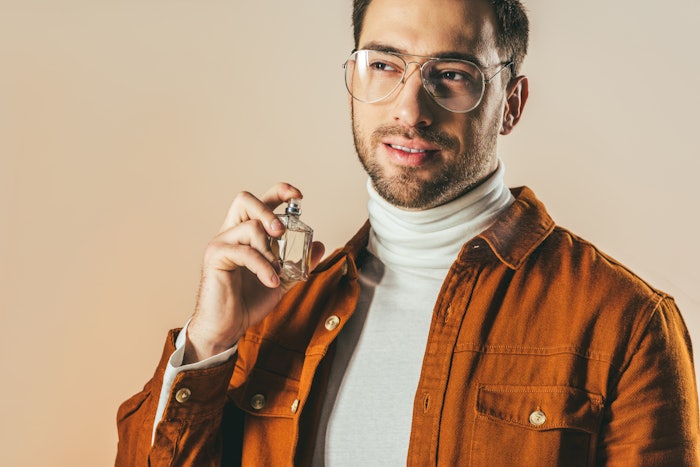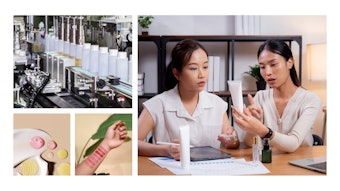
A new study in Science Advances examines how the natural human oxidation field can affect chemical exposures indoors – and how fragrances and personal care products such as body lotions alter these dynamics.
As the article explains, humans generate hydroxyl radicals (OH) in the presence of ozone through skin-emitted alkenes. Lotions containing phenoxyethanol or alcohol-based fragrance, however, were found to increase the reactivity of these radicals, consuming them and thereby reducing their overall concentration.
In vivo Materials and Methods + Simulation Models
Assessments were made using a fragrance-free body lotion containing linoleic acid (Neutral, Unilever body lotion for sensitive skin; 0% colorants and 0% perfume, per the article) and a commercial fragrance including linalool, a terpene alcohol present in lavender (CK One by Calvin Klein). Comparisons were also made combining the lotion and fragrance, and using linalool alone without alcohol.
Measurements were taken with four subjects who first were exposed to O3 in a temperature-controlled indoor chamber, following which they applied the body lotion or fragrance. Then, measurements were repeated.
"Combining air measurements from within the chamber with model simulations, we determined the net effect of the lotion and fragrance on the human oxidation field," the authors wrote.
Reaction and Consumption Dynamics
Beyond the lotion and fragrance increasing OH reactivity and decreasing OH concentrations, the authors observed additional dynamics.
Body lotion: The body lotion was found to suppress the production of 6-methyl-5-hepten-2-one, an OH precursor. It also "enhanced OH losses in the gas phase."
What's more, the linoleic acid in the body lotion reacted with OH. Plus, the application of the lotion was said to "effectively dilute the concentration of squalene on the skin surface available for reaction, thereby obstructing the O3-skin reaction."
Fragrance: The authors noted that while fragrances contain terpenes that can generate OH, their larger ethanol concentration reportedly acted as "a large OH sink." Indeed, linalool alone without ethanol was tested and increased reactivity initially, but only reduced the OH concentrations by less than 10%.
Lotion + fragrance: Finally, applying both the fragrance and lotion revealed that fragrances affected the OH reactivity and concentration more quickly, while lotions showed more persistent effects, "consistent with the rate of emissions of organic compounds from these [personal care products]."
"These findings have implications for the indoor chemistry of occupied spaces and human health," the authors concluded.
What implications could these findings have for the industry? Another layer of safety testing? Or could we spin this into a new "protective"-type claim? We asked a few industry experts for their insights.
New Focus On and Around Skin?
"As humans, we live in an environment full of oxidative insults both for the external and internal body," said dermatologist Zoe Draelos, M.D. "External oxidative insults include UV radiation, pollution and tobacco smoke. However, humans possess an oxidative field around them that interacts with the atmosphere and any topical skin care products."
She added that antioxidants are incorporated into many skin care products and can effectively reduce the inflammatory effects of UV radiation – but skin care products may also be able to quench reactive oxygen species (ROS) in the atmosphere around humans.
Draelos continued, "Typically, we focus on what is on the skin, but we may also need to focus on what is in the air surrounding the skin. Personal care products can place a protective layer over the skin and also positively impact the atmosphere contained in our personal space."
[update] 'Groundbreaking' Investigation
S. Peter Foltis, a technical consultant for skin care, photoprotection formulation, scale up, regulatory and claims support, and previous senior principal scientist at L'Oreal, shared his thoughts on this relatively new area of study.
"The concept of the human oxidation field is relatively new* and is the subject of much investigation," he wrote. "Hydroxyl radicals (OH) are highly reactive free radicals and can oxidize pollutants gases in the air. In the original paper, Zannoni, et al., found OH radicals in high concentrations when people were exposed to ozone in lab-controlled conditions.
"Ozone reacts with skin lipids (squalene) and generates OH radicals. This generates a field surrounding the body — a human-generated OH radical oxidation field — and was dependent on ozone exposure. They posited that this has implications for the oxidation, persistence and perception of indoor chemicals as well as human health.
"The present study is groundbreaking in that it took this concept a step further and investigated the effect of personal care products (PCP) on the human oxidation field. [The authors] examined two products — an unfragranced lotion and alcoholic fragrance. They demonstrated that a preservative in the lotion, phenoxyethanol and ethanol itself in the fragrance perturbed the oxidation field.
"Fragrances rapidly elevated OH reactivity. Lotions release compounds more slowly but effected the oxidation field for much longer period of time. Also, the lotion provided a physical barrier on the skin surface minimizing skin lipid oxidation."
He continued, "At first blush, minimizing the oxidation field seems like a good thing — it could reduce deleterious byproducts from skin lipid oxidation. On the other hand, one could be now exposed to other VOCs that the oxidation field would have otherwise quenched.
"When we think of pollution and chemicals in the air and overall air quality, we typically think of outdoor air pollution. However, more recently, data has been generated about indoor air pollution and is apparent that indoor air quality is impacting our health.
"While this study [evaluated] two products with relatively short ingredient lists, more complex formulas could pose different profiles. Further, layering of products would make some predictions more complex. The inclusion of antioxidants in PCPs, which has increased dramatically over the last decade, could further add complexity and would be an area of further research.
"When examining the human oxidation field — the micro environment clinging to the skin surface — one must include it in the larger discussion of the human exposome," he concluded.
* Nora Zannoni, et al. The human oxidation field. Science 377, 1071-1077 (2022).










